Hypotonic solutions - Study guides, Class notes & Summaries
Looking for the best study guides, study notes and summaries about Hypotonic solutions? On this page you'll find 1671 study documents about Hypotonic solutions.
Page 4 out of 1.671 results
Sort by

-
Exam 1: NR283 / NR 283 (Latest 2024/2025 Update) Pathophysiology Review with Questions and Verified Answers| 100% Correct | Grade A-Chamberlain
- Exam (elaborations) • 20 pages • 2024
-
Available in package deal
-
- $10.99
- + learn more
Exam 1: NR283 / NR 283 (Latest 2024/2025 Update) Pathophysiology Review with Questions and Verified Answers| 100% Correct | Grade A-Chamberlain Q: Which solutions cause a cell to swell? Answer: hypotonic solution Q: isotonic solution Answer: to a proportionate loss of fluid and electrolytes Q: hypotonic solution Answer: cell swells Q: Define Third-Spacing. What causes this? Answer: -movement of fluid out of the vas- cular compartment into a body cavity or...
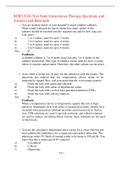
-
NURS 3320 Test Bank Intravenous Therapy Questions and Answers and Rationale,100% CORRECT
- Exam (elaborations) • 23 pages • 2022
-
- $15.99
- 1x sold
- + learn more
NURS 3320 Test Bank Intravenous Therapy Questions and Answers and Rationale 1. You are training nurses at your hospital to insert midline catheters. What would you teach the nurses about how many inches of the catheter should be inserted into the required site and for how long can it be used? A) 1 to 3 inches, used for up to 3 weeks B) 3 to 6 inches, used for up to 4 weeks C) 7 to 8 inches, used for up to 5 weeks D) 8 to 9 inches, used for up to 6 weeks Ans: B Feedback: A midline cathete...

-
NURS 611 / NURS611 Exam 1 (Latest 2024 / 2025 Update): Advanced Pathophysiology | Complete Guide with Questions and Verified Answers | 100% Correct | Grade A - Maryville
- Exam (elaborations) • 43 pages • 2024
- Available in package deal
-
- $7.99
- + learn more
Exam 1: NURS611 / NURS 611 (Latest 2024 / 2025 Update) Advanced Pathophysiology Exam Review | Complete Guide with Questions and Verified Answers | 100% Correct | Grade A - Maryville Q: ADH (water retention) and perception of thirst are stimulated by? Answer: Increased plasma osmolality Q: Osmolality increases or decreases with dehydration? Answer: Increases Q: Osmolality increases or decreases with over hydration Answer: Decreases Q: What is a normal sodium level? Answer: 135-145 meq/l Q: Sodium...

-
The S.T.A.B.L.E. Program - 6th edition With Complete Solutions.
- Exam (elaborations) • 12 pages • 2022
-
- $14.99
- 5x sold
- + learn more
c) All are correct (Increased work of breathing, bradycardia, asymmetric appearing chest, cyanosis, decreased femoral pulses) A neonate with a pneumothorax may exhibit which of the following signs? 1) Increased work of breathing 2) Bradycardia 3) Asymmetric appearing chest 4) Cyanosis 5) Decreased femoral pulses a) 1, 2, 4 b) 1, 3, 5 c) All are correct b) You are concerned because the infant's clinical presentation is not being adequately considered; work-up and treatment for ...
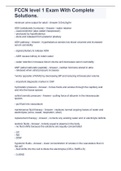
-
FCCN level 1 Exam With Complete Solutions.
- Exam (elaborations) • 13 pages • 2022
-
- $13.99
- 6x sold
- + learn more
minimum urine output for adult 0.5mL/kg/hr ADH (antidiuretic hormone) - water retainer - vasoconstrictor (also called Vasopressin) - produced by hypothalamus - store and released from posterior pituitary ADH pathway - hypothalamus senses low blood volumed and increased serum osmolality - signal pituitary to release ADH - ADH causes kidney to retain water - water retention increases blood volume and decreases serum osmolality ANP (atrial natriuretic peptide) -...
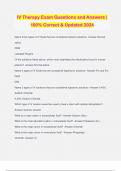
-
IV Therapy Exam Questions and Answers | 100% Correct & Updated 2024
- Exam (elaborations) • 19 pages • 2024
- Available in package deal
-
- $12.49
- + learn more
IV Therapy Exam Questions and Answers | 100% Correct & Updated 2024 Name three types of IV fluids that are considered isotonic solutions -Answer-Normal saline D5W Lactated Ringers Of the solutions listed above, which most resembles the electrolytes found in human plasma? -Answer-Normal saline Name 2 types of IV fluids that are considered hypertonic solutions -Answer-3% and 5% NaCl D50 Name 2 types of IV solutions that are considered hypotonic solutions -Answer-0.45% Sodium Chloride ...
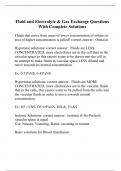
-
Fluid and Electrolyte & Gas Exchange Questions With Complete Solutions
- Exam (elaborations) • 46 pages • 2023
-
- $15.99
- + learn more
Fluids that move from areas of lower concentration of solutes to area of higher concentration is called? correct answer: Osmosis Hypotonic solutions: correct answer: Fluids are LESS CONCENTRATED, more electrolytes are in the cell than in the vascular space so this causes water to be drawn into the cell in an attempt to make fluids in vascular space LESS diluted and move towards its normal concentration. Ex: 0.33%NS, 0.45%NS Hypertonic solutions: correct answer: Fluids are MORE CONCEN...

-
Exam 2: NUR 3196 (Latest 2024- 2025 Update) Pathophysiology/ Pharmacology in Nursing 1 | Complete Review with Questions and Verified Answers- Grade A -100% Correct
- Exam (elaborations) • 77 pages • 2024
-
Available in package deal
-
- $11.49
- + learn more
Exam 2: NUR 3196 (Latest Update) Pathophysiology/ Pharmacology in Nursing 1 | Complete Review with Questions and Verified Answers- Grade A -100% Correct Q: Sodium (Na+) normal serum level Answer: 135 to 145 mEg/L Q: Sodium (Na+) roles Answer: - Regulates osmotic forces (water follows sodium) - nerve impulse conduction, acid-base balance, cellular biochem, membrane support Q: What is the primary ECF cation Answer: sodium Q: Isovolemic (euvolemic) hypern...
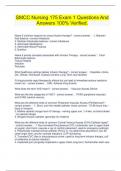
-
SMCC Nursing 175 Exam 1 Questions And Answers 100% Verified.
- Exam (elaborations) • 18 pages • 2024
-
- $12.49
- + learn more
SMCC Nursing 175 Exam 1 Questions And Answers 100% Verified. Name 5 common reasons for using Infusion therapy? - correct answer. 1. Maintain fluid balance / correct imbalance 2. Maintain Electrolyte balance / correct imbalance 3. Administer Medications 4. Administer Blood Products 5. Nutrition Name 4 priority concepts associated with Infusion Therapy - correct answer. Fluid Electrolyte balance Tissue Integrity Infection Perfusion What healthcare settings deliver infusio...
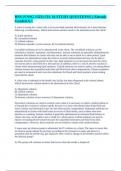
-
BNS (VNSG 1323) CH. 16 STUDY QUESTIONS || Already Graded A+.
- Exam (elaborations) • 10 pages • 2024
-
- $11.49
- + learn more
A nurse is caring for a client who is to be provided nutrition intravenously for a short duration following a tracheostomy. Which intravenous solution needs to be administered to this client? A) Lipid emulsion B) Crystalloid solution C) Colloid solution D) Plasma expanders correct answers B) Crystalloid solution Crystalloid solutions are to be administered to the client. The crystalloid solutions can be classified as isotonic, hypotonic, and hypertonic. Isotonic solutions are generally ...

Did you know that on average a seller on Stuvia earns $82 per month selling study resources? Hmm, hint, hint. Discover all about earning on Stuvia


